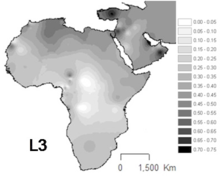Haplogruppe L3
| Haplogruppe der mitochondrialen DNA | |
|---|---|
| Name | L3 |
| Mögliche Ursprungszeit | vor 84.000 bis 104.000 Jahren |
| Möglicher Ursprungsort | Ostafrika oder Asien[1] |
| Vorgänger | L3'4 |
| Nachfolger | L3a, L3b'c'd'j, L3e'i'k'x, L3f, L3h, M, N |
| Mutationen | 769, 1018, 16311 |




Die Haplogruppe L3 ist in der Humangenetik eine Haplogruppe der Mitochondrien. Zur Haplogruppe L3 sind die Forscher der Ansicht, dass sie vor 84.000 bis 104.000 Jahren entstand.[4]
Sie ist vor allem in Ostafrika verbreitet, im Gegensatz zum Subsahara-Afrika, wo die Haplogruppen L1 und L2 rund zwei Drittel der mtDNA-Haplogruppen ausmachen.[5]
L3 ist unterteilt in mehrere Untergruppen, eine davon hat die Makrohaplogruppen M und N hervorgebracht, von denen die meisten Nichtafrikaner abstammen.
Nach Maca-Meyer u. a.(2001): „Haplogruppe L3 ist stärker mit eurasischen Haplogruppen verwandt als die divergierenden afrikanischen Cluster L1 und L2“.[6]
Stammbaum
Dieser phylogenetische Stammbaum der Subgruppen von Haplogruppe L3 basiert auf einer Veröffentlichung von Mannis van Oven und Manfred Kayser[7] und anschließender wissenschaftlicher Forschung.
- L3'4
- L3
- L3a
- L3b'c'd'j
- L3b
- L3b1
- L3b1a
- L3b1a1
- L3b1a2
- L3b1b
- L3b1b1
- L3b1a
- L3b2
- L3b1
- L3c
- L3d
- L3d1-5
- L3d1
- L3d1a
- L3d1a1
- L3d1a1a
- L3d1a1
- L3d1b
- L3d1b1
- L3d1c
- L3d1d
- L3d1a
- L3d2
- L3d3
- L3d3a
- L3d4
- L3d5
- L3d1
- L3d1-5
- L3j
- L3b
- L3e'i'k'x
- L3e
- L3e1
- L3e1a
- L3e1a1
- L3e1a1a
- L3e1a2
- L3e1a3
- L3e1a1
- L3e1b
- L3e1c
- L3e1d
- L3e1e
- L3e1a
- L3e2
- L3e2a
- L3e2b
- L3e2b1
- L3e2b2
- L3e3'4'5
- L3e3'4
- L3e3
- L3e3a
- L3e3b
- L3e4
- L3e3
- L3e5
- L3e3'4
- L3e1
- L3i
- L3i1
- L3i1a
- L3i1b
- L3i2
- L3i1
- L3k
- L3x
- L3x1
- L3x2
- L3x2a
- L3x2a1
- L3x2a1a
- L3x2a1
- L3x2b
- L3x2a
- L3e
- L3f
- L3f1
- L3f1a
- L3f1b
- L3f1b1
- L3f1b2
- L3f1b3
- L3f1b4
- L3f1b4a
- L3f1b4a1
- L3f1b4a
- L3f2
- L3f2b
- L3f3
- L3f1
- L3h
- L3h1
- L3h1a
- L3h1a1
- L3h1a2
- L3h1a2a
- L3h1a2b
- L3h1b
- L3h1b1
- L3h1b1a
- L3h1b1
- L3h1a
- L3h2
- L3h1
- M
- N
- L3
Einzelnachweise
- ↑ biorxiv.org
- ↑ Vicente M. Cabrera, Patricia Marrero, Khaled K. Abu-Amero, Jose M. Larruga: Carriers of mitochondrial DNA macrohaplogroup L3 basal lineages migrated back to Africa from Asia around 70,000 years ago. In: BMC Evolutionary Biology. Band 18, Nr. 1, 19. Juni 2018, ISSN 1471-2148, S. 98, doi:10.1186/s12862-018-1211-4, PMID 29921229, PMC 6009813 (freier Volltext).
- ↑ S. Vai, S. Sarno, M. Lari, D. Luiselli, G. Manzi, M. Gallinaro, S. Mataich, A. Hübner, A. Modi, E. Pilli, M. A. Tafuri, D. Caramelli, S. di Lernia: Ancestral mitochondrial N lineage from the Neolithic 'green' Sahara. In: Sci Rep. Band 9, Nr. 1, March 2019, S. 3530.
- ↑ Sarah A. Tishkoff u. a.: Whole-mtDNA Genome Sequence Analysis of Ancient African Lineages. In: Molecular Biology Evolution. Bd. 24, Heft 3, 2007, S. 757–768, ISSN 0737-4038.
- ↑ Douglas C. Wallace u. a.: Origin of haplogroup M in Ethiopia. In: American Journal of Human Genetics. Bd. 67, Supplement, 2000, S. 217, ISSN 0002-9297.
- ↑ Nicole Maca-Meyer u. a.: Major genomic mitochondrial lineages delineate early human expansions. In: BMC Genetics. Bd. 2, 2001, S. 13, ISSN 1471-2156.
- ↑ Mannis van Oven, Manfred Kayser: Updated comprehensive phylogenetic tree of global human mitochondrial DNA variation. In: Human Mutation. Band 30, 2009, S. E386. PMID 18853457. doi:10.1002/humu.20921.
Siehe auch
Webseiten
- Biologiezentrum Österreich zu Haplogruppe L3 ( vom 23. April 2008 im Internet Archive)
| Evolutionsbaum Haplogruppen Mitochondriale DNA (mtDNA) | ||||||||||||||||||||||||||||||||||||||||||||||||||||||||||||||||||||||||||||||||||||||||||||||||||||||||||||||||||
|---|---|---|---|---|---|---|---|---|---|---|---|---|---|---|---|---|---|---|---|---|---|---|---|---|---|---|---|---|---|---|---|---|---|---|---|---|---|---|---|---|---|---|---|---|---|---|---|---|---|---|---|---|---|---|---|---|---|---|---|---|---|---|---|---|---|---|---|---|---|---|---|---|---|---|---|---|---|---|---|---|---|---|---|---|---|---|---|---|---|---|---|---|---|---|---|---|---|---|---|---|---|---|---|---|---|---|---|---|---|---|---|---|---|---|
| ||||||||||||||||||||||||||||||||||||||||||||||||||||||||||||||||||||||||||||||||||||||||||||||||||||||||||||||||||
Auf dieser Seite verwendete Medien
Autor/Urheber: Nourdin Harich, Marta D Costa, Verónica Fernandes, Mostafa Kandil, Joana B Pereira, Nuno M Silva and Luísa Pereira, Lizenz: CC BY 2.0
Interpolation maps for L3 haplogroup in the sub-Saharan pool observed in each sample.
Autor/Urheber: Vicente M. Cabrera, Patricia Marrero, Khaled K. Abu-Amero, and Jose M. Larruga, Lizenz: CC BY-SA 4.0
Geographic origin and dispersion of mtDNA L haplogroups: a) Sequential expansion of L haplogroups inside Africa and exit of the L3 precursor to Eurasia. b) Return to Africa and expansion to Asia of basal L3 lineages with subsequent differentiation in both continents. The geographic ranges of Neanderthals, Denisovans and Erectus are estimates only
Autor/Urheber: Stefania Vai, Stefania Sarno, Martina Lari, Donata Luiselli, Giorgio Manzi, Marina Gallinaro, Safaa Mataich, Alexander Hübner, Alessandra Modi, Elena Pilli, Mary Anne Tafuri, David Caramelli, and Savino di Lernia, Lizenz: CC BY 4.0
Two possible models of L3's dispersal according to the Africa origin hypothesis (as represented by Vai et al.): (a) Haplogroup N differentiates from L3 in the African continent, with a subsequent spread out of Africa. (b) Haplogroups M and N diverged from L3 outside Africa or during the expansion of L3-carrying AMH out of the continent; later migrations during Early Upper Paleolithic and the Neolithic diffusion led some lineages back to North Africa.



